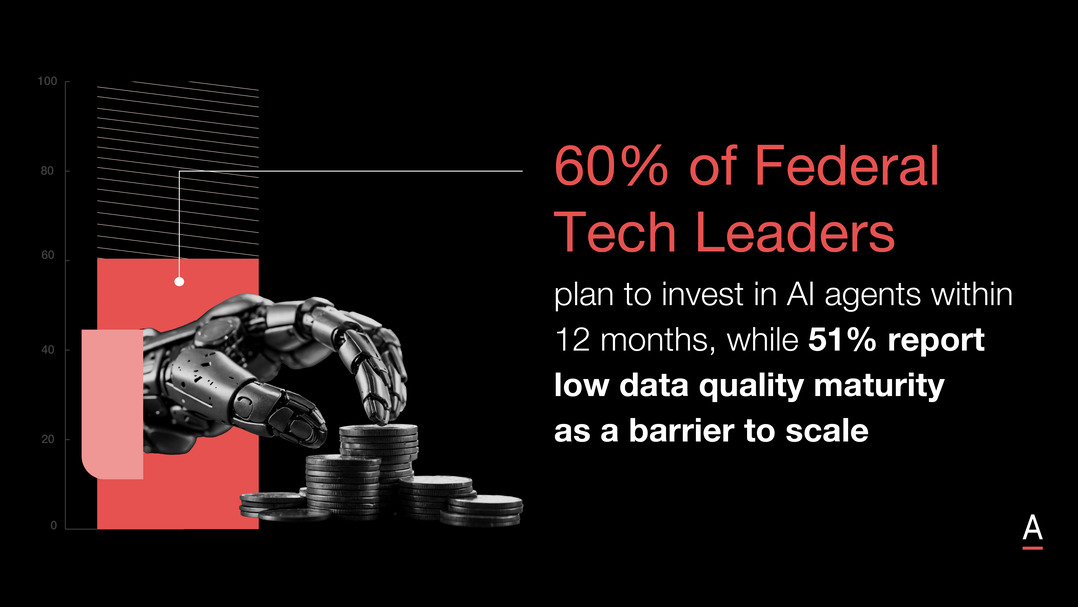4 Tech Trends that Will Shape 2024: A Look into Australia’s Generative AI, Cyber Security, and Cloud Migration Landscape, and Government Support
Unveiling the Future of Australian Tech in 2024: Generative AI, Cyber security, Gov't Funding, Cloud Migration, Data Strategy, & Digital Transformation with ADAPT.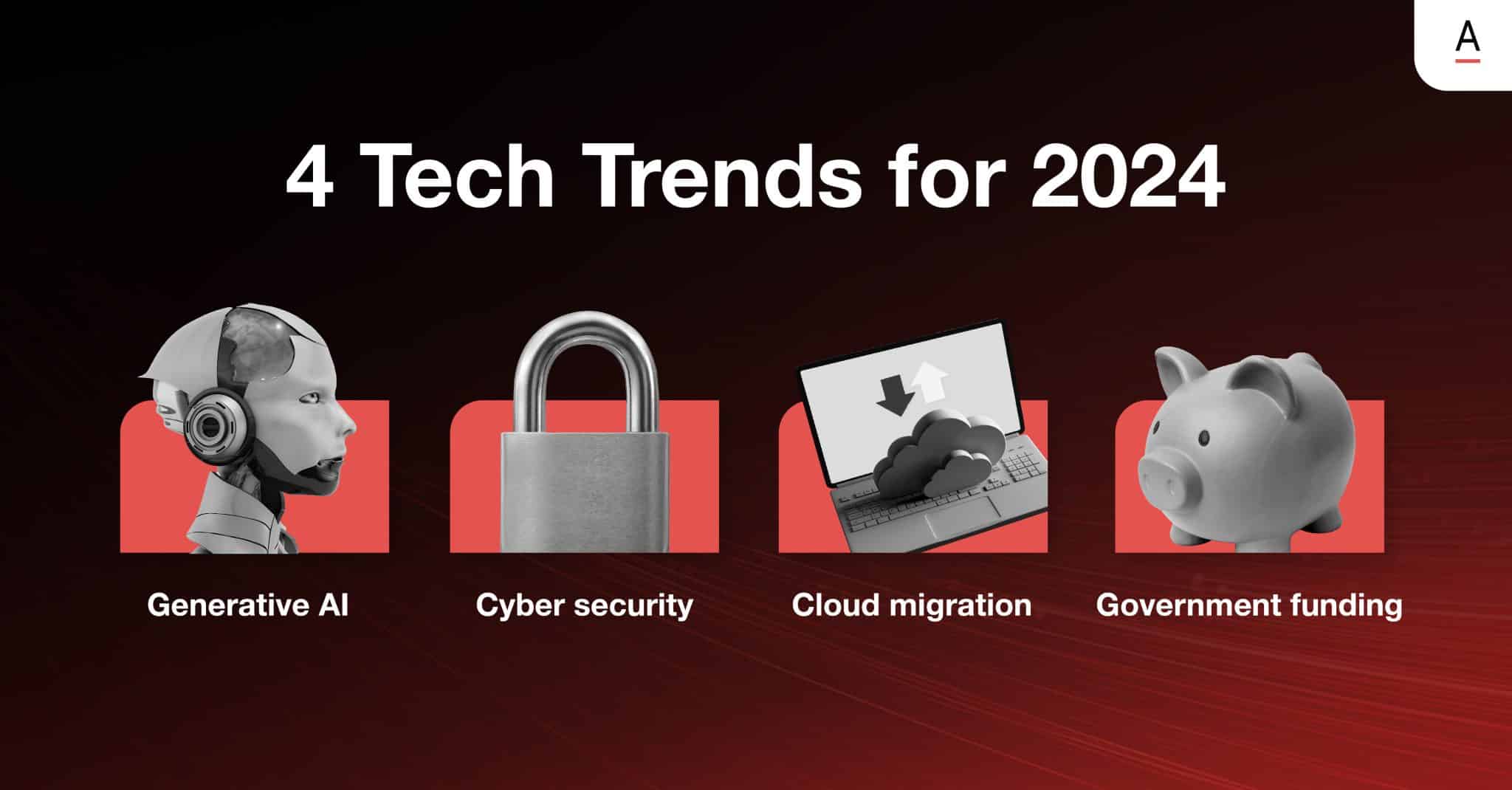
As we delve into the technological landscape of Australia, it becomes evident that several key themes will soon shape the business and IT sectors.
These pivotal areas include the adoption of Generative AI and cyber security, as well as substantial government funding for technology and education.
Moreover, cloud migration trends, data strategy evolution, and the challenges associated with digital transformation are all at the forefront of discussions among industry leaders and organisations.
ADAPT explores these influential factors expected to significantly impact the Australian market coming into 2024.
Generative AI
The business world is witnessing a surge in investments, adoption, and global adoption trends in Generative AI.
Its influence will not only permeate the tech sector but also impact the entire business world for many years.
The underlying message is clear: business leaders must recognise AI as a dynamic force that can enhance human capabilities, reshape traditional work modes, and accelerate the pace at which tasks are executed.
But harnessing this technology to stay competitive and innovative in an evolving business environment, organisations must make strategic decisions about investment, data literacy, and regional adoption.
1. Generative AI Gains Momentum in Australian Investments
Generative AI is becoming a key focus for investments in AI/ML, promising high returns on investment (ROI) shortly.Notably, the Australian market has witnessed a rapid increase in AI/ML investments, especially in Generative AI technologies.This heightened investment activity underscores the growing recognition of Generative AI’s potential to revolutionise various industries.
In a significant move, Amazon has committed a staggering $100 million to establish the AWS Generative AI Innovation Centre.This aims to accelerate enterprise innovation by harnessing the power of Generative AI, signaling a confident outlook for the ROI prospects of Generative AI technologies.
2. Australian Organisations Embrace AI/ML with Data Literacy Challenges
AI/ML technologies adoption is on the rise, with an impressive 75% of Australian organisations already using these technologies. Among them, 39% deploy AI/ML solutions, while another 36% pilot these technologies.
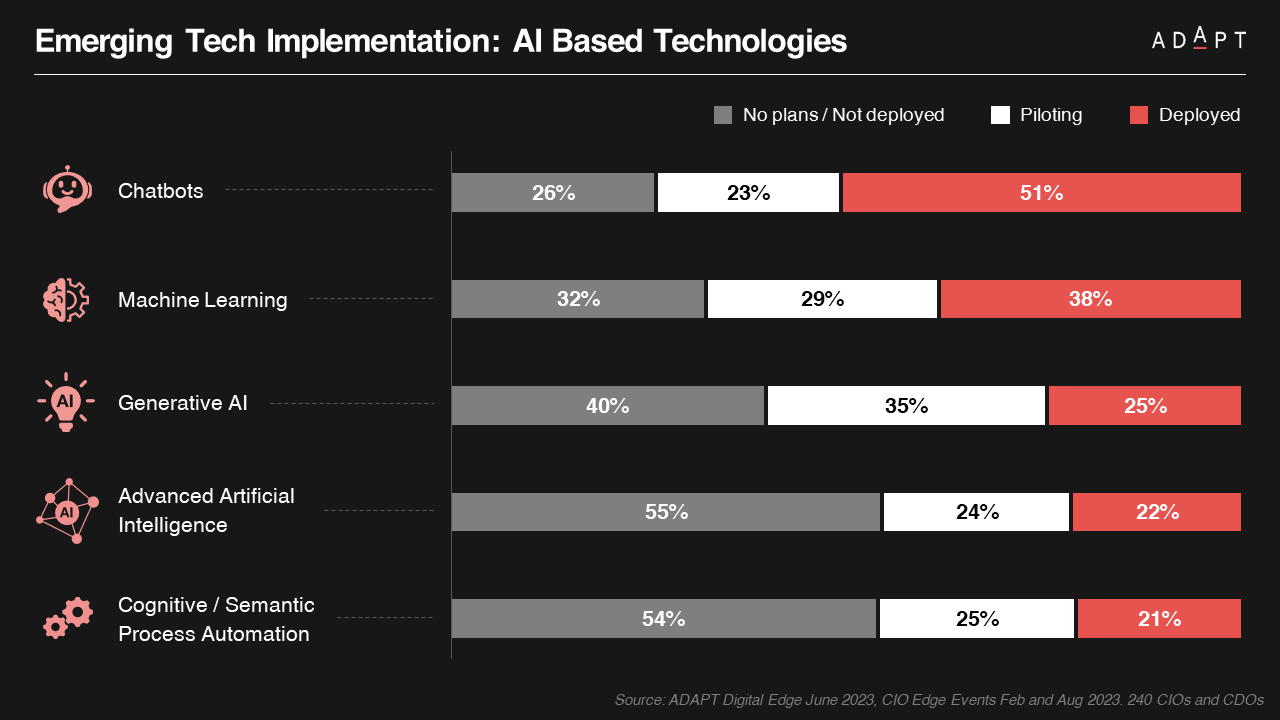
However, it is worth noting that despite this wave of adoption, challenges remain. Data literacy, a critical aspect of AI/ML utilisation, is a limiting factor.
Surprisingly, only 35% of users possess high data literacy skills. This could hinder organisations from make data-driven decisions accessible to everyone.

3. Global and Regional Trends in Generative AI Adoption
The adoption of Generative AI is not limited to a single region; it is a global phenomenon with distinct regional trends. According to an ADAPT study, developed Asia-Pacific regions and India stand out with high adoption rates, recording 64% and 65% adoption. These regions are at the forefront of integrating Generative AI into their business strategies.
Furthermore, according to the same study, the growth of AI-powered platforms is remarkable. ChatGPT, for instance, is expanding exponentially, with a growth rate of 3.8% daily.
TikTok took nine months to accumulate 100 million users, but ChatGPT achieved the same feat in two months.
These statistics demonstrate the global and regional dynamics in adopting Generative AI Technologies, underscoring its significance in today’s business landscape.
Investment & ROI
In the Australian technological landscape, two key trends are emerging as catalysts for a substantial return on investment (ROI):
- A rapid increase in AI/ML investments, particularly in Generative AI.
- Substantial investments in cloud migration.
These developments are poised to shape how businesses innovate and compete in Australia’s market.
1. Surging Demand for Cloud Migration Reflects ROI Focus
One striking trend is that more and more Australian organisations are seeking help moving to the cloud. This rise in interest demonstrates the transformative potential of cloud technologies, with a keen eye on the associated ROI. As businesses shift their workloads from in-house environments to a diverse mix cloud settings, scalability and efficiency enhancements become vital drivers.
ADAPT predicts that by 2025, 55% of Australian organisations’ workloads will find their home in public clouds.
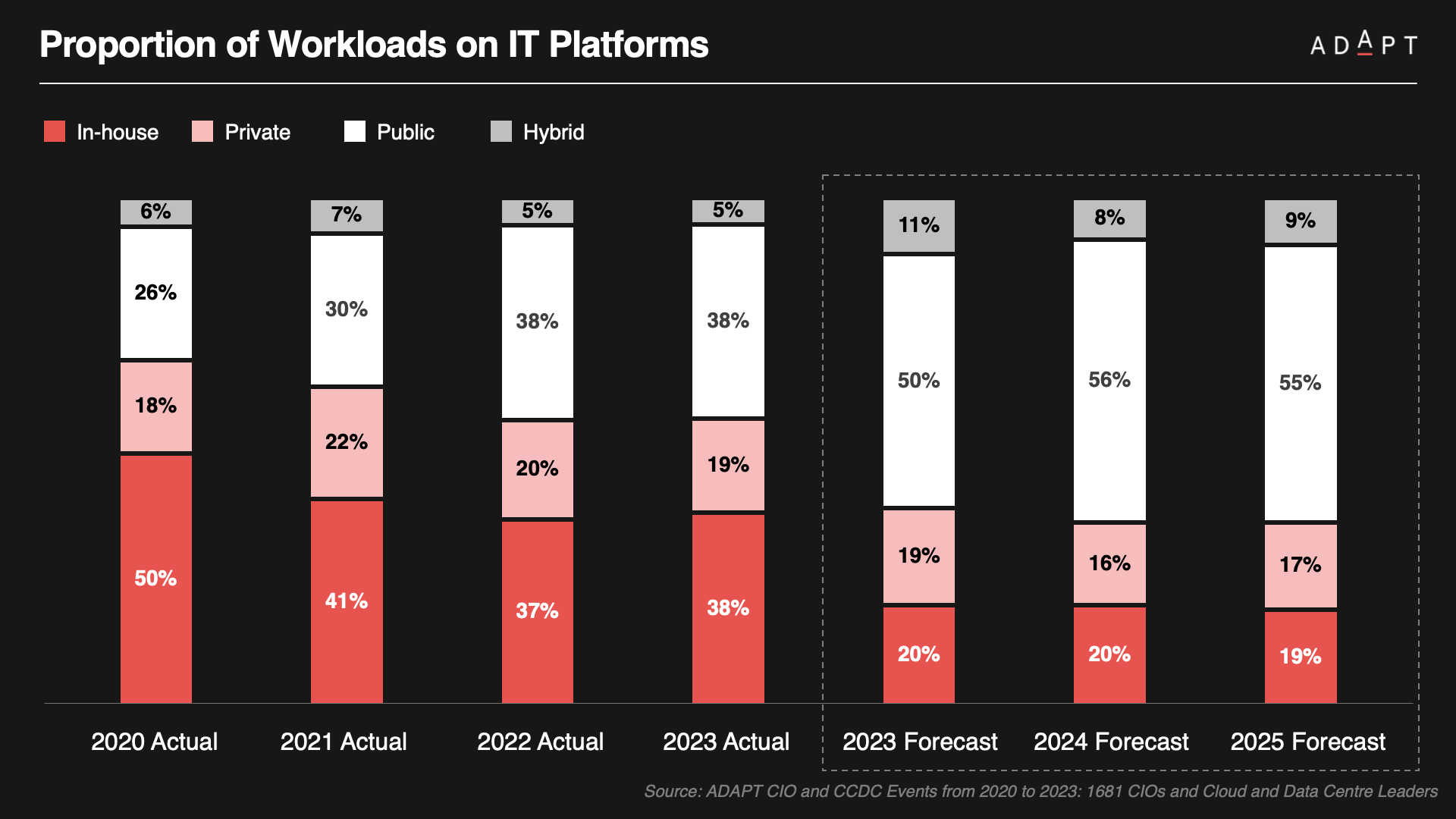
This shift signifies a dedication to getting the most out of cloud investments. Cost savings and flexibility are expected to contribute to return on investment significantly.
2. Australia’s Preferred Public Cloud Vendors Shape AI/ML ROI
Choosing the right cloud partner is critical for organisations embarking on AI/ML journeys.
In this context, Microsoft Azure and Amazon Web Services (AWS) have emerged as Australia’s preferred public cloud vendors.
Such preferences show substantial investments in cloud services, which are critical for AI/ML work.
Choosing the right cloud platform affects the success of AI/ML projects and overall ROI.
3. Empowering ROI through Effective Cloud Platform Selection
Despite the undeniable benefits of cloud migration, several hurdles must be cleared. Legacy systems in organisations can pose challenges due to associated costs and complexities during migration.
Recognising and overcoming these obstacles by moving to cloud environments can lead to long-term cost savings, operational efficiencies, and improved ROI.
Amazon’s $100 million investment in its AWS Generative AI Innovation Centre within the Australian market underscores the critical context of cloud migration and cloud services.
These components are the foundational pillars supporting AI/ML projects, including those in the realm of Generative AI.
As a result, they greatly influence the potential return on investment for tech investments in Australia.
Literacy
Today, CIOs and technology leaders in Australia actively embrace digitalisation to discover new revenue streams and promote technology-driven growth.
As organisations ramp up their digitalisation efforts, they observe significant enhancements in their operational value extraction.
Technology Leaders Actively Embrace Digitalisation for Revenue Growth
CIOs and technology leaders are exploring digitalisation to unlock potential new revenue streams and facilitate technology-driven growth.
A survey conducted at the ADAPT CIO Edge involving 160 CIOs found that half of the respondents have adopted digitalisation to varying degrees across their organisation’s operations, ranging from 35% to 65%.

As organisations increase their digitalisation efforts, they experience a significant improvement in their ability to extract value from their operations.
According to the same survey, highly digitalised organisations reported a 60% effectiveness rate.
To improve customer value and increase revenue, involve sales and customer service teams in solving operational issues and harnessing digital channels.
Cyber Security
The rampant incidences of security breaches in Australian businesses have called for a renewed focus on security and resilience
Driven by the imperative to protect their organisations and stakeholders, the response of CISOs reflects their strategic commitment to building secure, resilient, and operationally efficient business environments.
1. Urgent Call for Strengthening Cyber Defenses
In 2022, 46% of Australian organisations fell prey to spear phishing attacks, highlighting the urgent need to strenghten defences against this specific cyber threat.
The insight emphasises the importance of robust security measures, employee awareness, multi-factor authentication (MFA), and adapting to an evolving threat landscape.

Cyber security vigilance is crucial as spear phishing continues to pose a severe risk.
Organisations must take proactive steps to mitigate this threat and protect sensitive data.
ADAPT conducted a study with 242 CISOs and Heads of Security. The study revealed the top security concerns for 2023, illustrating the gravity of these cyber attacks:
- Data security is the primary concern, with 86% of respondents expressing worry.
- Phishing attacks and social engineering closely follow at 82%.
- Identity theft and ID issues are a concern for 79% of participants.
- Ransomware is a significant worry for 76% of those surveyed.
- Third-party security risks concern 67% of the respondents.
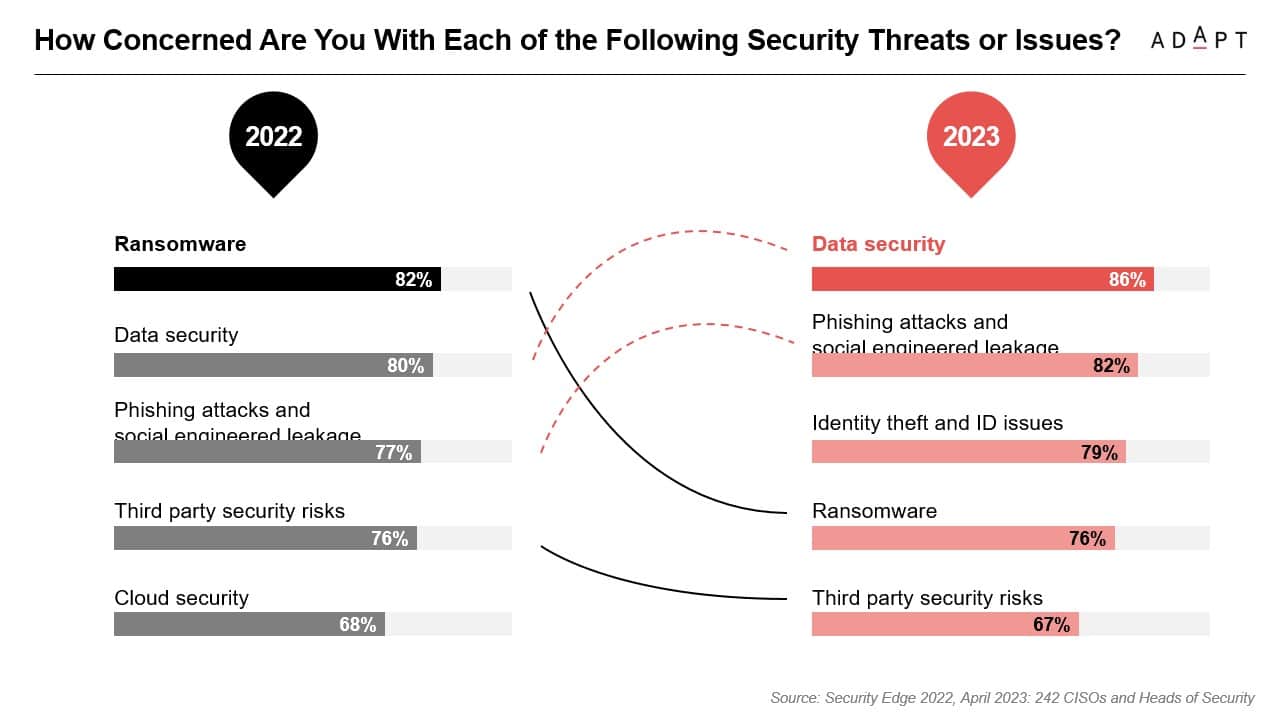
2. SOTI’s Research Reveals Alarming Healthcare Data Breach Trends
SOTI’s research reveals data breach statistics, as 78% of global healthcare providers offering frontline services have reported at least one breach since 2021.
The study involved 1,450 healthcare IT professionals across various countries, shedding light on the evolving landscape of healthcare technology adoption.
According to the same study, 91% of Australian healthcare IT professionals express profound concerns about patient record security.
At the same time, accidental data leaks have risen, with 43% of Australian organisations reporting such incidents, up from 35% in 2022.
This upward trend has resulted in a significant rise in data leaks. 66% of healthcare organisations in Australia have experienced planned or accidental data leaks, while 63% have faced data breaches due to external sources or DDoS attacks.
These breaches lead to financial costs, regulatory penalties, and erode trust between patients and healthcare providers.
3. Surging Breaches Drive Australian Business Focus on Security and Resilience
As the business environment in Australia constantly changes, security breaches are surging.
Data from ADAPT indicates that 1 in every 4 Australian businesses has encountered a security breach, starkly contrasting the previous quarterly occurrences.
The violations, once sporadic, have now become a weekly menace.
In response to this growing threat, Chief Information Security Officers (CISOs) across the nation have placed security and resilience at the pinnacle of their agenda for the forthcoming year.
The pressing need to fortify digital defences has driven Australian CISOs to redefine their
priorities over the next 12 months, with a primary focus on:
- Building a Secure and Trustworthy Organisation:
First, build a secure business environment to prevent breaches and inspire stakeholder trust. Security measures should protect against attacks and reassure stakeholders about data integrity and privacy.
- Enhancing Resilience Against Operational and Market Risks:
With increased breach frequency, Australian businesses know operational and market-based risks. CISOs are enhancing resilience for continuity in the face of adversity.
- Boosting Operational Effectiveness:
CISOs aim to enhance operational effectiveness, streamline workflows, optimise processes, and boost productivity alongside stringent security standards.
4. The Federal Budget 2023 Aims to Boost Cyber security and Public Investment
Cyber security and public investment take centre stage in the annual Federal Budget, providing an opportunity to explore various initiatives and financial allocations.
These budgetary insights often reveal valuable technology and business projects within larger enterprises that might have been overlooked.
The budget for this year focuses on dealing with the high cost of living and updating old infrastructure and processes that are seen to slow down progress.
Consequently, the budget emphasises that upgrading technology is both a business and government challenge.
Several ICT upgrade projects have been announced and funded, including those with substantial benefits for Australians.
In cyber security, the government has allocated $101.6 million over five years, starting in 2022–23, with an additional annual budget of $11.8 million for ongoing cyber security enhancement.
Government Funding and the Federal Budget 2023
The 2023 Australian Federal Budget aims to drive innovation and economic growth. It will provide funds to enhance financial stability, update infrastructure, and promote technology-driven growth.
Cyber security remains a priority, even with a slightly reduced budget allocation.
These budgetary insights show Australia embracing technology and innovation to improve and fortify its economic and technological landscape.
Estimations suggest the total expenditure may approximate $3.7 billion over four years.
1. Technology Enhancement & Economic Growth
The Australian Government’s 2023 Federal Budget aims to drive innovation and tackle economic challenges.
It allocates $162.4 million over four years starting in 2023-24, with an additional annual commitment of $8.3 million for the Treasury portfolio.
The primary goal is to enhance economic stability, address the cost of living, modernise infrastructure, and promote technology-driven economic growth and job creation.
Cyber security receives notable attention due to recent high-profile incidents despite a slightly reduced budget allocation.
The budget emphasises improving citizen well-being through strategic investments in energy, science and technology, aged care, cyber security, marine science, and sustainable finance.
In Science and Technology, $116 million will be invested over five years, beginning in 2022-23, to develop vital technology for economic growth and job creation.
Starting in 2023-24, the government has allocated $163.4 million over four years and $43.5 million annually to ensure the financial sustainability of the Australian Institute of Marine Science (AIMS).
2. STEM & Education Funding
Australia also focuses on enhancing STEM (Science, Technology, Engineering, and Mathematics) capabilities with a significant investment spread over four years.
These initiatives work towards innovation, economic resilience, and overall societal welfare.
An investment of $132.7 million, spread over four years starting in 2023-24, with an additional annual commitment of $17.3 million, is allocated to enhance STEM capabilities, expand capacity, and amplify outreach efforts.
Cloud Migration
Australian organisations swiftly embraced digital transformation pressures during the pandemic by migrating workloads to the cloud.
1. Australia’s Cloud Migration Shapes the Digital Future
Based on insights from 2,000 Australian tech executives since 2019, ADAPT’s yearly cloud migration study offers a comprehensive view of this shift across public, private, and hybrid cloud environments, highlighting the industry’s adaptability.
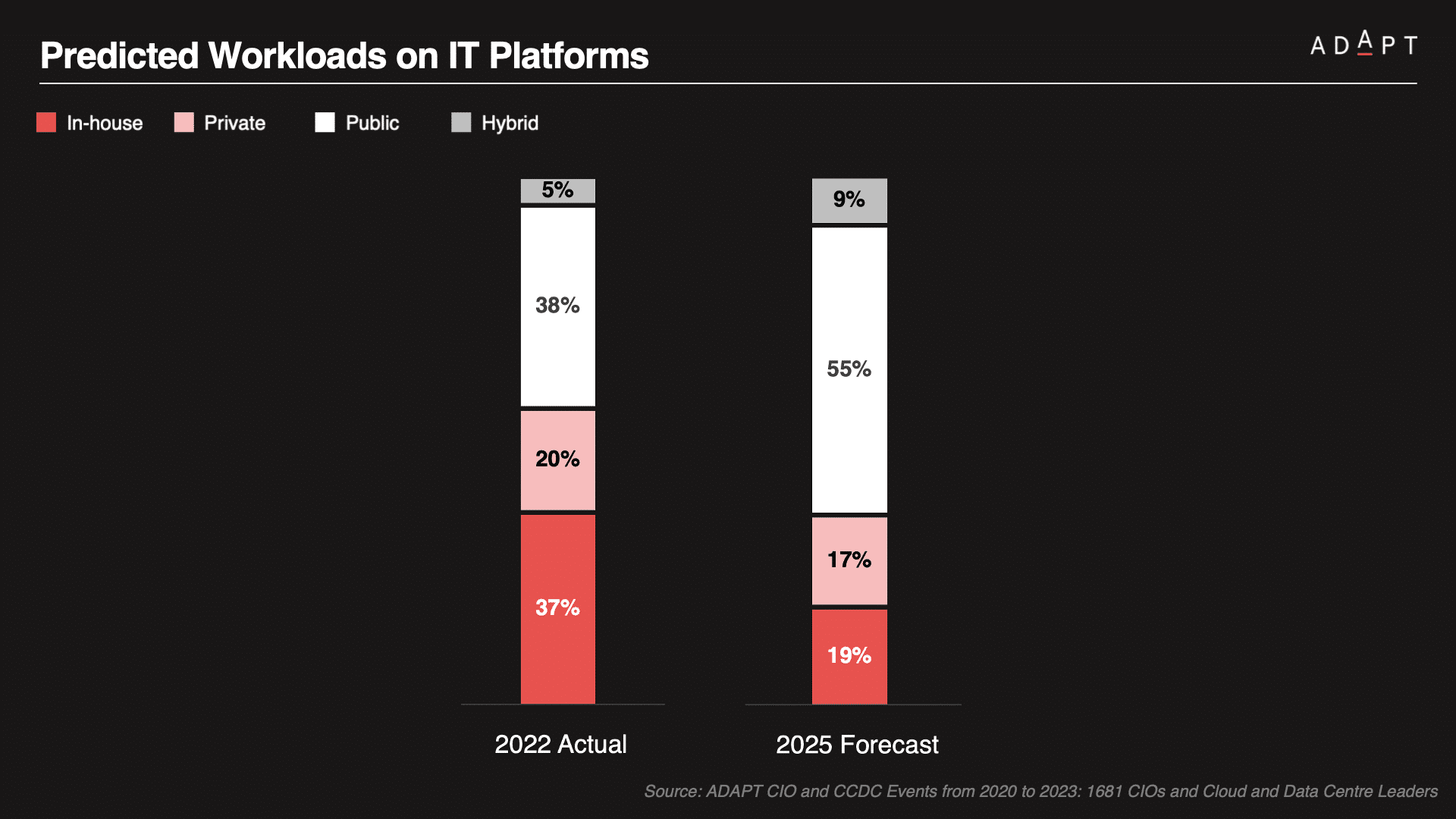
This transition has sparked a growing need for cloud migration support. By 2025, 55% of workloads will be in public clouds.
The driving forces behind this shift are the flexibility of scalability, support for remote work arrangements, and the financial efficiency cloud platforms offer.
The same study reveals an intriguing facet: 11% of Australian infrastructure leaders plan to repatriate their workloads from public clouds in 2023.
This inclination is primarily observed among small and medium-sized organisations, as larger enterprises are committed to their cloud strategies.
Among the businesses leading the way, highly modernised organisations host an impressive 67% of their workloads in public clouds, highlighting the appeal and adaptability of these platforms
The major impediment to cloud migration in Australia is the deeply ingrained legacy systems present in many organisations.
Initially, cloud migration can be costly. Justifying this expense can be difficult, especially when legacy systems still work, albeit inefficiently.
Aside from legacy systems and applications, architectural considerations, lack of in-house talent, unexpected migration and operational expenses can delay cloud migration.

Looking ahead to 2025, adopting public clouds for mission-critical applications will be a pivotal driving force
Decision-making factors will revolve around cost-effectiveness, scalability, and the compatibility of workloads, which will also influence the course of repatriation strategies.
2. Australian Organisations Re-evaluates Cloud Strategies
ADAPT research reveals a shift in cloud strategies, with 18% of organisations now using over five public cloud environments, while 9% reconsidering and repatriating workloads from the public cloud.
This shift highlights a broader market reevaluation driven by the complexities of managing multi-cloud environments and interoperability challenges.
As a result, some organisations are pivoting towards in-house colocation or private clouds, resulting in the need for a transformation in cloud migration strategies.
The research suggests cloud providers should collaborate with other vendors to improve customer visibility in multi-cloud environments.
On the other hand, technology leaders should evaluate workload suitability and perform asset auditing before migrating to public cloud, emphasising framework development for cloud success.
Digital Transformation
In digital transformation, achieving success hinges on strategic alignment, customer-centric strategies, and overcoming legacy challenges.
1. Fostering Strategic Synergy for Digital Transformation Success
ADAPT highlights the paramount significance of a well-aligned strategy to drive digital transformation.
This is crucial because a cohesive strategy ensures that all aspects of an organisation, including digital initiatives, data utilisation, and human resources, work harmoniously towards common goals.
Furthermore, ADAPT stresses the key role of synergy among digital, data, and human resources.
This synergy enables organisations to maximise their data and technology, leading to improved digital transformation and enhanced performance.
Furthermore, this highlights the crucial significance of real-time customer insights, which allow organisations to stay agile and responsive to evolving customer needs.
In addition, optimising agile team structures ensures efficient and effective project delivery while cultivating a digital-first organisational culture that fosters innovation and competitiveness in the ever-changing digital landscape.
2. Gaining Key Insights for Successful Digital Transformation
ADAPT Digital Edge 2023 underlines the vital significance of three core pillars in digital transformation. These are foundational for organisations seeking digital excellence.
Digital Innovation: Emphasising the need for a digitally savvy workforce, promoting a culture of digital fitness, and adopting data-driven approaches.
This includes digitising financial reporting for informed decision-making, optimising agile team structures, and fostering transformative innovations.
Customer-Centric Strategies: Prioritising the customer perspective to enhance value in operational and ecosystem strategies and improve the overall customer experience.
Real-time customer insights are pivotal for agility and responsiveness.
Alignment of Key Stakeholders: Highlighting the necessity of aligning critical stakeholders with the digital strategy.
This involves securing executive support, efficient resource allocation, and demonstrating the value of digital investments.
3. Australian Organisations Struggle with Legacy Challenges
Legacy issues are a significant obstacle for 50% of Australian organisations, undermining their progress and causing a decline in our nation’s global rankings in crucial indices like productivity, innovation, and digital growth.
These organisations have grappled with aligning their systems with the evolving demands of the business world for over two decades.
The role of Chief Information Officers (CIOs) has evolved with the rapid evolution of the global landscape, bringing new complexities and expectations.
Following the disruptive data breaches of 2022, establishing a trusted and secure organisation has become a critical focus and challenge for executives in 2023.
In today’s environment, CIOs face mounting pressures to provide consistently resilient services, demonstrate the value of technology investments, and spearhead technology-driven growth and innovation.
Meeting these expectations demands a substantial leap forward, requiring a comprehensive overhaul of operating models, architecture, skills, cultures, metrics, and approaches.
























